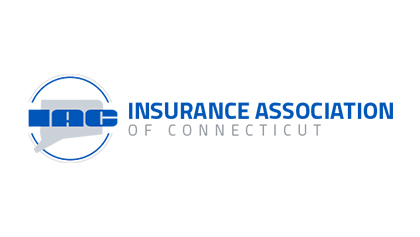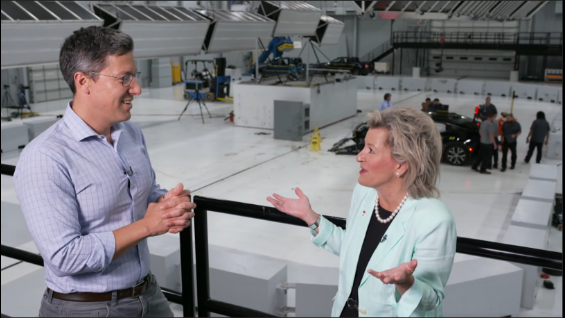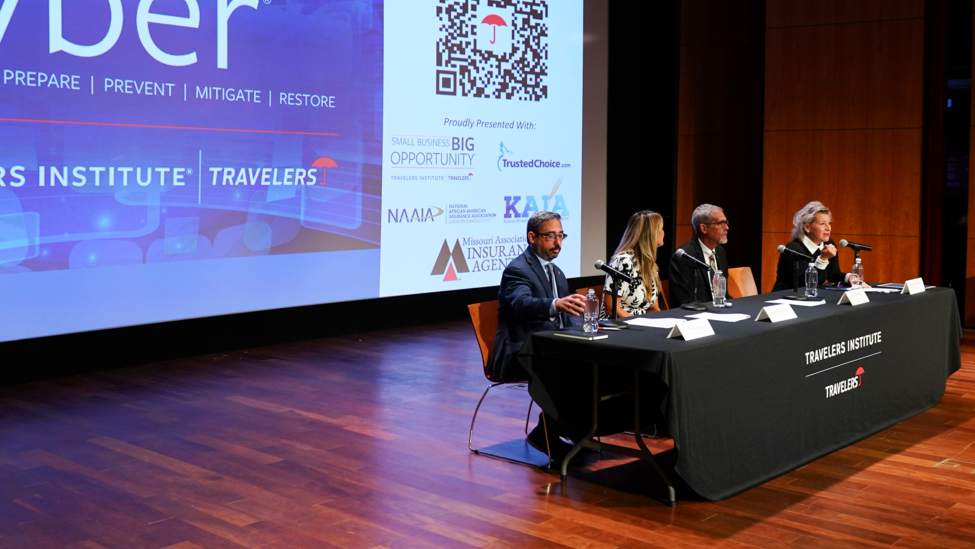ADAS in the Wild

ADAS in the Wild
September 13, 2023
Wednesday 1:00 p.m.-2:00 p.m. ET
This Wednesdays with Woodward program is proudly presented as part of the Travelers Institute’s Every Second Matters® initiative, which empowers drivers, passengers, cyclists and pedestrians to speak up, set positive examples and play an active role in changing roadway behaviors to help prevent injuries and save lives.

Newer vehicles today are packed with sensors and technology. This includes a group of features known as Advanced Driver Assistance Systems (or ADAS), that aim to help drivers better react to danger on the road and partially automate the driving task. So how are drivers today actually handling all this new tech? Are we beginning to see safety benefits? In this Travelers Institute webinar, we joined Dr. Bryan Reimer as he shared insights from MIT’s Advanced Vehicle Technology Consortium, which studies real life drivers in and around New England operating some of today’s most tech-forward vehicle models. Travelers’ Personal Insurance Vice President Amanda Mezerewski got into the conversation as well for a deep dive on the state of ADAS, its safety benefits, limitations, consumer understanding and more.
Watch webinar replay
(SPEECH)
[MUSIC PLAYING]
(DESCRIPTION)
Slide, Wednesdays with Woodward (registered trademark) Webinar Series. Travelers Institute (registered trademark). Logo, Travelers.
(SPEECH)
JOAN WOODWARD: Good afternoon, everyone. Thank you so much for joining us. I'm Joan Woodward, and I'm honored to lead the Travelers Institute, the public policy division and educational arm of Travelers. Welcome to our fall 2023 kickoff of Wednesdays with Woodward.
I hope you all had a terrific summer and got in some vacation time and time with family. As always, this is a series where we explore critical issues at the intersection of insurance, business and public policy. Before we get started, I'd like to share our disclaimer about today's program.
(DESCRIPTION)
Slide, About Travelers Institute (registered trademark) Webinars. Text, The Wednesdays with Woodward (registered trademark) educational webinar series is presented by the Travelers Institute, the public policy division of Travelers. This program is offered for informational and educational purposes only. You should consult with your financial, legal, insurance or other advisors about any practices suggested by this program. Please note that this session is being recorded and may be used as Travelers deems appropriate. Travelers Institute (registered trademark). Logo, Travelers. Slide, A.D.A.S in the Wild. Text, Wednesdays with Woodward (registered trademark) Webinar Series. Logos, Every Second Matters (registered trademark). University of South Carolina Darla Moore School of Business. Travelers Institute (registered trademark), Travelers. Insurance Institute for Highway Safety, Highway Loss Data Institute. MetroHartford Alliance. Connecticut Business & Industry Association. University of Connecticut School of Business, Master's in Financial Technology. Insurance Association of Connecticut.
(SPEECH)
Newer vehicles today are packed with sensors and technology. This includes a group of features known as advanced driver assistance systems, systems in your vehicle that help you better react to dangers on the road, and even partially automated driving. So think about things like blind spot monitoring or automatic emergency braking.
We want to know, how are drivers today actually handling all this technology? Are people using these systems or simply turning them off? And are we beginning to see safety benefits? We're going to explore all of it. And, going a step further, we'll take a peek into some of the partially automation systems as well.
So before we get started, a huge thanks to our cohosting organization and partners who are helping advance these important safety conversations-- the Master’s in FinTech Program at UConn School of Business, the Risk and Uncertainty Management Center at the University of South Carolina's Darla Moore School of Business, MetroHartford Alliance, and the Connecticut Business & Industry Association, the Insurance Association of Connecticut and the Insurance Institute for Highway Safety. Thank you, all, to our wonderful partners.
We're going to start today with opening presentations from two fantastic speakers, followed by a moderated discussion, and then, importantly, your questions. So get those questions ready, and pop them in the Q&A for us throughout the program.
So with that, I'm thrilled to introduce our speakers.
(DESCRIPTION)
Slide, Speakers. On the left is a portrait of a woman with short blond hair in a white blouse and necklace. Text, Joan Woodward, EVP, Public Policy; President, Travelers Institute, Travelers. In the middle is a portrait of a man with short red hair in a dark suit. Text, Bryan Reimer, Ph.D. Research Scientist, Center for Transportation and Logistics and MIT AgeLab; Founder and Co-Director, Advanced Vehicle Technology Consortium; MIT. On the right is a portrait of a woman with shoulder-length light brown hair in a black and white checkered shirt. Text, Amanda Mezerewski, Vice President, Personal Insurance Auto Product, Travelers.
(SPEECH)
First up, Dr. Bryan Reimer is a Research Scientist at MIT's Center for Transportation Logistics at the MIT AgeLab. Dr. Reimer's research centers on driver behavior, driver attention and distraction, automation and the use of ADAS. He is a renowned and respected leader on these topics, and it's a true privilege to host him on the show today.
Among his many accolades, awards and accomplishments, he has authored over 250 technical contributions related to transportation and human factors. And his research has been featured in nearly every major U.S. media outlet. Dr. Reimer has founded and leads three academic partnerships with industry, including the Advanced Vehicle Technology Consortium, of which Travelers is a very proud member. This group seeks to understand how drivers use emerging commercially available vehicle technologies.
This means Dr. Reimer truly sees the latest tech being used in the wild, as we say. And he's got some great stories to share with us. So we're thrilled you're with us, Dr. Reimer.
Next up is Amanda Mezerewski, is Vice President in Personal Insurance here at Travelers and leads our Auto Product Team. She has responsibility for strategic planning and financial results within the automobile line of business. Amanda previously held leadership roles at Travelers within Product, with responsibility for regional P&Ls across Auto and Property. She has tremendous insight into the trends we're seeing in the personal insurance auto lines and brings a great deal of perspective today.
With that, I'm going to turn it over to Dr. Reimer for his opening presentation. Welcome, Bryan.
(DESCRIPTION)
On the left, a car drives down a tunnel. Slide, Wednesdays with Woodward: A.D.A.S. in the wild. Bryan Reimer, Ph.D., MIT Center for Transportation and Logistics, MIT AgeLab. September 13, 2023.
(SPEECH)
BRYAN REIMER: Thanks, Joan. And thanks for the warm welcome from the Travelers team and for having me here today. So, I'm going to talk a little bit today about some of our work at ADAS, research in the wild.
(DESCRIPTION)
Slide, Automation as an Evolving Process. Text, We are talking about it more, but the ship set sail decades ago! Three photos show a stick shift, a gear shift and a person driving with a smart phone at their ear. The first is labeled Manual, the second, Automatic, and the third, Increased Distraction. Text, Automatic transmissions reduce drivers’ operational workload. Drivers use the “freed up” resources to do other things! Copyright 2023 MIT AgeLab.
(SPEECH)
First, we keep talking about automation more and more. We hear about it in the news almost daily now. But automation is really an evolving process. And the ship set sail decades ago.
Thinking about the yesteryears of automotive technology, well, we automated transmissions. We added power steering, electronic stability control, all with different elements of supporting the driver. So who would ever have thought that automatic transmissions would make it so much easier to take your hand off the clutch, mind off the road, and pick up that cell phone and begin using those freed resources to do other things? So who would really want to drive a car every day anymore without power steering? And power steering is automation.
So automation's applications in safety, convenience, comfort and even sustainability just continue to grow. It's clear that a lot of what we're automating is to make driving easier, more comfortable and hopefully safer along the way. Advanced driver assistance systems, such as AEB, forward collision warnings, lane departure warnings, all aim to support driver safety, while other advanced features, such as Level 2 automation and adaptive cruise control, aim to enhance convenience.
Hopefully, if well designed, these assistance systems focused on convenience can also provide some safety benefits. But a lot more data is going to be needed to better quantify these changes and how activities, such as speeding behavior, headway and more passive driving weigh with other risks, such as increased distraction and other related tasks.
For now, we need to focus on the realities, that for the foreseeable future, driver assistance is here. This differs from how highly automated technologies are being tested in certain parts of the world and how certain organizations out there toss around marketing terms, like self-driving or full self-driving. In fact, nothing today is truly full self-driving on public roadways. Even the robotaxis being tested in California have human operators in the back office helping to remotely support the technology when decisions get hard and the vehicle itself can't make robust decisions on its own. So for the foreseeable future, the vast majority of miles traveled will be driven by humans.
(DESCRIPTION)
Slide, A Key Problem. Text, Autonomy Means Different Things to Different People. Some possible perspectives on objectives (use cases) of autonomy include: Bullet list, bullet 1, Vehicles and vehicle systems that encompasses aspects of hands-free driving? Bullet 2, Autonomous mobility on demand services (without safety drivers) in a neighborhood or city? Bullet 3, A mobility ecosystem that provides seamless intermodal connectivity? Bullet 4, A mobility solution that meets a target safety threshold? Text, quote, When it comes to autonomous vehicles, technologists, automakers, politicians and drivers see the world through different lenses, end quote. Reimer, B. (2018). Why We Need To Define Success In Our Evolution Toward Self-Driving. Forbes. Reimer, B. (2018). There’s more to the safety of driverless cars than AI. TEDxWaltham. Copyright 2023 MIT AgeLab.
(SPEECH)
So when we start talking about autonomy, it means different things to different people. Technologists, automakers, policymakers, manufacturers, insurers all see the world through different lenses. Some perspectives that I talked about a few years ago in a Forbes blog post, thinking about vehicles and vehicle systems that encompass hands-free driving, automated mobility systems on demand without a safety driver in a neighbor or city, a mobility ecosystem that provides seamless, intermodal connectivity, or perhaps where I like to think of the world most, a mobility solution that meets a targeted safety threshold.
So we can all look at automation from different perspectives. And automation is supporting all of these perspectives differently to different people. And we need to begin to think much more coherently, how do we support humans in their role through the mobility system?
(DESCRIPTION)
Slide, What is the Driver's Role? In two pictures, on the left, a driver holds the steering wheel, versus on the right, they do not hold the wheel. Text, Is There a Need for a Global Terminology Movement Away from Levels? Driving & Riding may be the only terminology distinction that consumers clearly understand without significant education. Seppelt, B., Reimer, B., Russo, L., Mehler, B., Fisher, J. & Friedman, D. (2019). Consumer Confusion with Levels of Vehicle Automation. Proceedings of the 10th International Driving Symposium on Human Factors in Driver Assessment, Training, and Vehicle Design. Santa Fe, New Mexico. Copyright 2023 MIT AgeLab.
(SPEECH)
When we talk to consumers, there's a lot of consumer confusion out there. We have confusion on what the driver's role may be, when we are responsible for driving and when we may not be responsible, perhaps a need to move away from global terminology that has been focused on levels of automation for years now to a simplified term. I am driving, and I am responsible for all the aspects of vehicle control and safe mobility, or I am riding, much like the yesteryears of being a passenger, and I am not responsible for anything at that given point in time. And somebody else is working to support the automation or the taxi driver is.
Clearly, consumers have a difficult time differentiating between more than a binary A/B decision. I'm driving now, but I also need to monitor the automation. And perhaps maybe I'm not quite fully responsible. And we see the legal questions of this developing. So I think it's beholden to industry stakeholders to really begin to think here about separating driving from riding. And let's move away from that taxonomy of levels.
(DESCRIPTION)
Slide, Acceptance of Vehicle Automation. Text, Trends Show Continued Interest in assistance. A graph titled What is the maximum level of automation you would be comfortable with? shows data from the years 2016 to 2021 in vertical percentage bars. Key, Beige. No automation. Light red. Emergency only. Features that are usually inactive, but activate only in certain events such as a collision. Red. Driver assist. Features that actively help the driver while the driver remains in control. Dark red. Partial self-driving. Features that relieve the driver of all control for periods of time. Maroon. Full self-driving. Features that completely relieve the driver of all control for the entire drive. Note: Percentages shown are unweighted. Driver assist and partial self-driving grow over time as emergency only and full self-driving shrink. Text, Lee, C., Gershon, P., Reimer, B., Mehler, B. & Coughlin, C. (2021). Consumer Knowledge and Acceptance of Driving Automation: Changes Over Time and Across Age Groups. Proceedings of the Human Factors and Ergonomics Society Annual Meeting, 65(1), 1395 to 1399. Unpublished 2021 MIT AVT Survey Data. Copyright 2023 MIT AgeLab.
(SPEECH)
When we talk to folks about their interest in automation, it seems quite uniform. Some survey data we started collecting in 2016 and collected in the years since and more recently in partnership with J.D. Power really begins to show quite strongly, drivers are looking for automation that helps assist them. They're not looking to be replaced. They're not looking for just automation that works in emergency situations only. They're working for systems that really assist them. That's the background, at the end of the day, of driver assistance systems, a range and suite of technologies that aim to support the driver.
(DESCRIPTION)
Slide, The need for a new data driven approach to success. Text, Advanced Driver Assistance Systems (ADAS) and Automated Driving Systems (ADS) are predicated on a set of conditional operating characteristics, yet: Bullet list. Bullet 1, Drivers may not have the understanding and skills necessary to successfully leverage technologies. Bullet 2, Many systems require driver management and oversight. Bullet 3, Technologists often assume ideal performance of both the human and system. Bullet 4, Infrastructure is less than ideal. Past research into ADAS and ADS is limited in scope and context when it comes to understanding how actual consumers interact with such technology in everyday driving. On the right, two red circles with a not equals sign between them read, Projected benefits based upon testing, and, Real-world benefits based upon crash and claims data. The not equals sign is labeled, Why are systems often less effective than projections? Copyright 2023 MIT AgeLab.
(SPEECH)
So when we begin to think about driver safety systems, active safety systems and even automated driving features, what we begin to very quickly understand is that we often as an insurance industry or manufacturers begin to project the benefits of these technologies early on in the design process. We start to think about how good this technology can be, what its potential might be. But when we begin to look at real-world benefits, whether that's behavior of individuals and vehicles we study at MIT or in real-world claims data, we very quickly often recognize that systems are far less effective than our projections.
Lane departure warning systems were hailed as a major safety breakthrough. And we found that they did not work to the degree we expected. Lane keeping assist systems seem to provide more benefits. Antilock braking systems not as beneficial as projections. Only when combined with electronic stability, have we seen the benefits we're looking for. Even the benefits of automatic emergency braking, which have led to a collaborative mandate across the industry, really are not showing the real-world benefits that we once perceived should exist.
There's some reasons for that. Often drivers don't have the skills and understanding necessary to work with these technologies and successfully leverage them in the real world. Education is a need.
Many systems require driver management and oversight in ways outside the capabilities of the human. Technologists often assume that the technology is going to work perfectly, and the human's going to behave. But yet we all seem to frequently get diverted from the roadway to answer a phone call or send a text.
And, finally, our infrastructure is often less than ideal. Three-foot craters in the road during New England winters don't marry with high technology either easily.
So this is not to say that past research in ADAS and automated driving systems is wrong. It's not. It's just limited in scope and context when it comes to understanding how actual customers interact with such technology every day.
(DESCRIPTION)
Slide, AVT. The Advanced Vehicle Technology Consortium. Text, Focus: To collect and analyze cutting edge data that objectively characterizes the behavioral and safety benefit of advanced driver assistance systems, higher levels of automation, and other in-vehicle technologies under real-use conditions. Originators: MIT AgeLab, Touchstone Evaluations & Agero. Founding Members: Aptiv, Liberty Mutual, Jaguar Land Rover, Veoneer & Toyota. Current Members, asterisk, member affiliates in parenthesis: Agero, Allstate, Aptiv, Audi (VW, Cariad), Autoliv, BMW of North America, Bosch, CCC Intelligent Solutions, Consumer Reports, Google (Waymo), Honda, Insurance Institute for Highway Safety, Jaguar Land Rover, JD Power, Nissan, Progressive, Thatcham Research, Arriver, Seeing Machines, Subaru, Travelers, Toyota (TMC, TRI, TIMS), Veoneer, & Zenseact (Volvo Cars). Other Supporters: The LAB (GIE Stellantis & Groupe Renault), TravelCenters of America, Lear, & Santos Family Foundation. On the right, a Venn diagram is titled, Looking Beyond the Technology Towards Consumer Understanding, and includes three overlapping circles labeled, Environment, Technology and Human. The diagram is also labeled Driver-Technology Interaction Dynamic. Text, To develop: An understanding of system performance and how drivers adapt to, use (or do not use), and behave with advanced vehicle technologies. Copyright 2023 MIT AgeLab.
(SPEECH)
Based upon this gap, in an industry-wide understanding and need for understanding why there is such a disconnect, eight years ago, we formed the Advanced Vehicle Technology Consortium as an effort to collect and analyze data that helps objectively characterize how drivers are leveraging advanced driver assistance systems and other higher-level forms of automation in the wild. Today, our nearly 30 partners are learning with us through a very unique partnership that allows individuals from a range of backgrounds, such as engineering, product strategy, legal, regulatory affairs, corporate research, to learn and discuss findings together.
It's really key that when we watch organizations working with us, what they are learning from MIT data is great, but what they are learning from each other is even more important. What's key here is that the understandings of these systems are complex. How drivers in the wild engage and where they use and where they do not use technologies is more than one industry alone can solve or one company can focus on, collaboration being a key to success.
(DESCRIPTION)
Slide, Moving Beyond Experimental Data: Real World Findings on Super Cruise (SC) Initiated Disengagement. A graph with the x-axis labeled Seconds from negative 10 to 10 in increments of 5 and the y-axis labeled Proportion of Steering Level from 0.00 to 1.00 in increments of 0.25. Key, Hands on the steering wheel, black, two, gray, one, red, none. The red begins at 0.75 and lowers after 0 seconds to almost 0. The black begins at almost 1, then lowers to 0.75 after 0 seconds. The gray fills in between them. Text, When both hands were off the wheel, drivers took on average 0.6 seconds (33%) longer to actively steer as compared to drivers who had at least one hand on the wheel (2.4 seconds to 1.8 seconds). The implications of this are not yet established. Gershon, P., Mehler, B. & Reimer, B. (2023). Driver response and recovery following automation initiated disengagement in real-world hands-free driving. Traffic Injury Prevention. 24(4), pp. 356-361. Copyright 2023 MIT AgeLab.
(SPEECH)
Just an illustration of some work here by my colleague Pnina Gershon, moving beyond experimental data, looking at how Super Cruise-initiated disengagements occur in the real world. There's been lots of work for years now in driving simulators, looking at how the automation calling for human intervention is going to result in a behavioral outcome. Very little work to date on how this occurs in the wild.
So what we see here is that when drivers are asked to take control, it takes on average about 0.6 seconds to actively steer when they had one hand on the wheel prior to the disengagement and about 2.4 seconds when they had two. The implications of this in terms of safety are not yet well established. There's a whole lot of features and technology at play in this vehicle.
But what's key here is we begin to sense some real-world benchmark data. And we can begin looking for different systems to improve on this. What the work begins to really tell us, at the end of the day, is that design matters. It's really impossible to effectively average across systems. And when we do so, we often miss the mark in truly understanding what the benefits and limitations of specific implementations are.
Whether it's a Level 2 system or automatic emergency braking, each engineering approach is unique. Each comes with attributes that lead to successful product utilization and attributes that may lead to less successful utilization.
Consumers rarely behave like test subjects. They text. They speed. They ignore traffic controls. They get frustrated. The value of naturalistic data is it allows organizations to learn from the data, assess where their controlled engineering tests and their risk assumptions are correct and where they may be missing the mark.
As we move forward in fusing what automation has to offer with that of an attentive driver, we should see severe-- severity and frequency of accidents reduced. But unfortunately, I think for the foreseeable future, as we continue a bumpy on-road of more assistance, we're probably going to see the frequency of collisions and excessive losses increase over the foreseeable future. Quite simply, as a society, we've not yet-- we're fascinated-- we're not yet fully embracing human-centered design. And we're fascinated with sensing and control and automation technologies.
(DESCRIPTION)
Slide, Leveraging Technologies for Risk Mitigation. Text, Driver Monitoring & Support Systems. Bullet list. Bullet 1, Driver attention may be at a historic low and there are clear risks that assistive automation may exacerbate this problem. Bullet 2, Driver monitoring and support systems can offer benefits under all automation levels, but the impact of production implementations on risk is unknown. Bullet 3, Increased automation needs to be coupled with increased comfort, convenience, reduced environment impact, and safety, but also requires that systems help support a “driver’s” new role. Sub-bullet 1, Monitoring, Sub-bullet 2, Collaboration, Sub-bullet 3, Readiness to take-over. Bullet 3, Data on driver behavior, vehicle system status, and the operating context may be critical to risk and liability management, however, new approaches are needed to leverage data to actively support drivers in our quest for a safer system. Text, Coughlin, J.F., Reimer, B. & Mehler, B. (2011). Monitoring, Managing and Motivating Driver Safety and Well-Being. IEEE Pervasive Computing. On the right is a copy of a journal article page. Text, Copyright 2023 MIT AgeLab.
(SPEECH)
The most important technology that I see on the horizon in our work is really driver monitoring and support systems. Driver attention may be at historic lows. And there's a clear indication that assistive automation may exacerbate this problem.
It's time we look past the fact of using sensing and path-planning technology to drive the vehicle itself and take some of the same fundamental elements of artificial intelligence and focus that on monitoring and connecting the driver to these systems. Driver monitoring and support system can offer benefits under all automation levels, but the impact of production systems on risk is not yet known. The Europeans seem to be well ahead of us in the United States at adopting and pressing for the use of these systems.
What's clear is that as we automate, we need to couple the automation with increased comfort, convenience, reduced environmental impact and safety. But this requires the driver to take on a new role, a role that involves monitoring, a role that involves collaboration and a role that involves readiness to take over.
So when we look to the future, data on driver behavior, vehicle system status and the operating context may be critical to risk and liability management. However, we need to leverage this data actively to support the driver at the time of decisions in the vehicle in our quest for a safer system. Instead of racing to automate, we still need to produce and enhance systems that include humans. Yes, we will still have human error. But, as we can see in the news reports from robotic vehicles in California, robots make mistakes, too.
(DESCRIPTION)
Slide, The Future May be Electrified and Highly Automated, But... Text, An Agreement on Benefits Will Be a Key to Success. Bullet list. Bullet 1, Safety targets are life and death decisions that impact a range of costs for suppliers, manufacturers, and insurers. Ultimately these are costs born by the consumer. Bullet 2, Given advertised promises, non-optimal deployment of enhanced safety and convenience systems risks eroding consumer trust in future automation. This may also be a missed opportunity to excite and delight the customer while simultaneously mitigating an ongoing health crisis on our roads. Bullet 3, Society needs a common pathway to safer, greener, and more economical transportation with clearer, collaboratively set, and clearly communicated goals. Automation and electrification offer opportunities to develop a better system. Bullet 4, Government needs to take an active role, with all parties willing to collaborate. Bullet 5, Continual process improvement offers an opportunity, because what is safe enough and green enough today will not be enough tomorrow! On the right, a graphic displays broken circles on the top labeled public and private, versus, joined circles on the bottom with the same labels. Text, Reimer, B. (2018). There’s more to the safety of driverless cars than AI. TEDx Waltham. Copyright 2023 MIT AgeLab.
(SPEECH)
So as we look to the future, yeah, we will see lots of highly automated vehicles developed. But the vast majority of the miles traveled are going to be human driven. Safety targets are life-and-death decisions that impact a range of costs for suppliers, manufacturers, insurers and the like. Ultimately, however, these costs are borne by the consumer.
Automation today is changing how we drive. And electrification is probably just exacerbating this. Automation leaves drivers perceiving that they need less attentive to the road-- attention to the road. Electrification provides performance characteristics and incredible acceleration.
Given advertised promises, nonoptimal deployment of safety and convenience systems risks eroding consumer trust in the future of automation. This also may be a missed opportunity in how to excite and delight the customer or simultaneously mitigating the ongoing health crisis on a road.
At the moment, driver skills, situational awareness and an understanding of the driving environment are continuing to decrease. Society needs a common pathway to a safer, greener and more economical transportation system with clear, collaboratively set goals. And automation and electrification offer opportunities for a better system, but they need to be combined together with human expertise and human understanding.
Given the already high loss ratios, we can see that the industry alone is not going to solve this. Government needs to take on active roles, with everybody willing to collaborate. What's clear here is continual process improvement is the opportunity because what's safe enough or green enough today will not be tomorrow. Only if we work together as a private sector with the public sector are we really going to consider the role of the driver, the insurer, the manufacturer and the system at large together. And with that, I'll turn things over to Amanda.
(DESCRIPTION)
A white domed building with many columns stands behind a parking lot with several cars parked in an arch. Slide, Questions? Text, Bryan Reimer, Ph.D., reimer @ M.I.T. dot edu. Logo, MIT AgeLab.
(SPEECH)
AMANDA MEZEREWSKI: Thanks, Bryan.
(DESCRIPTION)
Slide, A.D.A.S. In the Wild. Logo, Travelers.
(SPEECH)
All right. So, as Bryan mentioned, the technology and features within vehicles have advanced significantly over time and in many ways is reshaping the driving task.
(DESCRIPTION)
Slide, A.D.A.S. Technologies and Insurance. Text, What impact have these collision avoidance technologies had on the reduction of crashes and related injuries and deaths? What potential impact will they have on the future? A.D.A.S. In the Wild. Logo, Travelers.
(SPEECH)
Bryan mentioned that vehicle technology means different things to different stakeholders. Within the insurance industry, an important question we have is, what impact have these collision avoidance technologies had on the reduction of crashes and related injuries and deaths? The Highway Loss Data Institute, whom Travelers is a member group of, have been studying advanced driver assistance systems for over 12 years and to date has published 100 studies-- over 100 studies on the real-world benefits based on crash and claims data.
The following set of slides from HLDI summarizes the results from some of those studies. Moving forward, each bar-- if we can move forward. Thank you.
(DESCRIPTION)
Slide, Summary of technology effects on insurance claim frequency. A chart has percentages on the y-axis from negative 40% to positive 40%. The categories across the x-axis are Forward collision warning (FCW), FCW with autobrake, Adaptive headlights, Lane departure warning, Side-view assist (blind spot), Parking sensors, Rear camera, Rear automatic emergency braking. The bars in each category are brown, Collision, yellow, Property Damage Liability, red, Bodily Injury Liability, blue, Medical Payments Coverage, and purple, Personal Injury Protection. The bars begin at the 0% line and almost all extend downward. Only the red bar in the category Lane departure warning noticeably goes up. The red, blue, and orange bars in the Forward collision warning (FCW), FCW with autobrake, and Rear automatic emergency braking reach down to negative 20%, while the others are in between 0 and negative 20%. Text, A.D.A.S. In the Wild. Logo, Travelers.
(SPEECH)
Each bar on this slide represents a change in claims frequency, the number of times a claim is made for a technology by coverage type while controlling for other characteristics, such as the presence of other technologies, rated driver demographics and garaging location. The larger the bar is, the more effective the technology is on reducing insurance claim frequency.
(DESCRIPTION)
All categories except Forward collision warning (FCW), FCW with autobrake, and Rear automatic emergency braking fade out.
(SPEECH)
Moving forward, some of these technologies are associated with larger reductions in claim frequencies, such as forward collision warning, front auto brake, and rear automatic emergency braking, also known as AEB.
(DESCRIPTION)
Those three categories fade out and Adaptive headlights, Lane departure warning, and Side-view assist (blind spot) color back in.
(SPEECH)
On the next slide, we can see that curve adaptive headlights and blind spot warning systems are associated with modest reductions. And, finally, Bryan made mention in his presentation on this, lane departure warning systems, at least as a stand-alone technology, is the only technology summarized here that is not associated with a statistically significant reduction in claim frequency.
(DESCRIPTION)
Those three categories fade out, and Forward collision warning (FCW), FCW with autobrake, Parking sensors, Rear camera, and Rear automatic emergency braking color back in.
(SPEECH)
Moving on, when we look at technologies that warn the driver versus similar technologies that act on behalf of the driver, the implementation that acts on behalf of the driver is typically associated with larger reductions in claim frequencies. We see this phenomenon on the left side of the slide, with forward collision warning systems compared to front auto brake systems. Here you can see the property damage, orange bar, and the red, bodily injury bars, for front autobrake are larger than those within forward collision warning.
We also see this occur on the right-hand side of the slide when we look at systems designed to help people park their cars. The frequency reductions associated with parking sensors and rear camera are more modest as compared to rear automatic emergency braking, which will automatically apply the brakes if something is detected in its path.
(DESCRIPTION)
Slide, Estimated changes in injury-related claim frequency associated with A.D.A.S. bundles. A chart y-axis goes from negative 40% to 20% in increments of 10, with categories across the x-axis and bars beginning at 0 and all extending downward. The bars in each category are brown, Collision, yellow, Property Damage Liability, red, Bodily Injury Liability, blue, Medical Payments Coverage, and purple, Personal Injury Protection. The categories on the x-axis are all split into two, with Optional on the right of each pair and, from left to right, A: FCW+LDW+ A.E.B., B: A+ACC, C: B+BSW+RCTA, D: B+rear parking sensors, E: D+front parking sensors, F: D+AHL, G: D+rear A.E.B., and H: C+rear parking sensors+AHL. The red and orange bars are consistently the lowest, between negative 30 and 40%, while brown is often between 0 and negative 10% and blue and purple between negative 10 and roughly 25%. Text, A.D.A.S. In the Wild. Logo, Travelers.
(SPEECH)
Moving forward, increasingly advanced driver assistance systems are sold to consumers in bundles of technology. Said another way, some of the technologies described on the prior slide can only be purchased with one another. HLDI has begun evaluating the effects of a variety of technology bundles that you see displayed here. In one of the most recent studies, it was found that vehicles equipped with most of the technologies described on the earlier slide are associated with reductions in claim frequencies for property damage liability and bodily injury liability approaching 40%.
(DESCRIPTION)
Slide, Estimated changes in physical damage claim severity associated with A.D.A.S. bundles. A chart y-axis goes from negative 40% to 20% in increments of 10, with categories across the x-axis and bars beginning at 0 and all extending upward. The bars are in two colors, brown, Collision, and yellow, Property damage liability. The categories on the x-axis are all split into two, with Optional on the right of each pair and, from left to right, A: FCW+LDW+ A.E.B., B: A+ACC, C: B+BSW+RCTA, D: B+rear parking sensors, E: D+front parking sensors, F: D+AHL, G: D+rear A.E.B., and H: C+rear parking sensors+AHL. In the first three, the brown bar tends to be higher and both bars stay between 0 and 10%. In the middle two, the bars are roughly equal, between 0 and 10%. In the last three, the yellow bar tends to be higher and rises over 10%. Text, A.D.A.S. In the Wild. Logo, Travelers.
(SPEECH)
So at this point, ADAS is clearly able to reduce claim frequency. But an important question that we also ask is, what impact do these advanced systems have on severity or the average dollars paid out when a claim does occur? On this slide, we can see that overall, ADAS features contribute to a higher average repair cost when crashes do happen.
This is primarily driven by two reasons. Firstly, the technology in vehicles is more costly and, therefore, drives a higher average severity. And secondly, these technologies are very good at eliminating low-dollar claims. So think your really minor bumps and crashes. This results in an overall increase in the average value for the claims that do remain.
(DESCRIPTION)
Slide, Estimated changes in physical damage overall losses associated with A.D.A.S. bundles. A chart y-axis goes from negative 40% to 20% in increments of 10, with categories across the x-axis and bars beginning at 0 and all extending downward. The bars are in two colors, brown, Collision, and yellow, Property damage liability. The categories on the x-axis are all split into two, with Optional on the right of each pair and, from left to right, A: FCW+LDW+ A.E.B., B: A+ACC, C: B+BSW+RCTA, D: B+rear parking sensors, E: D+front parking sensors, F: D+AHL, G: D+rear A.E.B., and H: C+rear parking sensors+AHL.In all cases, the yellow bar extends far below the brown, reaching between negative 10 and 30%, while the brown stays around negative 5%. Text, A.D.A.S. In the Wild. Logo, Travelers.
(SPEECH)
Moving forward, even with the higher average severity, the absolute levels of frequency, HLDI has found, far outweigh any increase in average costs. And, therefore, the impact that ADAS bundles have on the reduction of total physical damage loss dollars is still substantial, particularly for property damage, as denoted on this slide with the yellow bars.
(DESCRIPTION)
Slide, Real World Implications. Bullet list. Bullet 1, What percentage of registered vehicles today and into the future are equipped with these systems? Bullet 2, Systems need to remain on by drivers in the vehicle. Bullet 3, Drivers need to remain attentive to respond to warnings and interventions. Text, A.D.A.S. In the Wild. Logo, Travelers.
(SPEECH)
So Bryan talked a lot about projections relative to actual crashes. And we can see in the slides leading up that HLDI has used real-life data to suggest some notable improvements in absolute values. A really key question for us at this point is, how long will it take for us to see these pervasively impact us overall?
And so really, there's three main pieces that are important in the real-world implication. Firstly, how many vehicles in the vehicle fleet are equipped with these systems today? And how many are projected to have these systems in the future?
Secondly, it's very important that these systems remain turned on by the drivers within the vehicle. And then thirdly, it's incredibly important that drivers remain attentive while performing the driving task in order to respond to the warnings or interventions that the technology is providing.
(DESCRIPTION)
Slide, Estimated registered vehicles by feature. A bar chart with vehicle feature categories on the x-axis and percentage on the y-axis, from 0 to 80 in increments of 20. The categories on the x-axis are Rear camera, Rear parking sensors, Front crash prevention, Blind spot monitoring, Lane departure warning, Front automatic emergency braking, Curve-adaptive headlights, and Adaptive cruise control with lane centering. The chart displays two bars per category for calendar years 2022, in yellow, and 2027, in orange. The orange bars are all roughly 20% higher than the yellow bars. The overall height of the bars falls to the right. Text, A.D.A.S. In the Wild. Logo, Travelers.
(SPEECH)
Moving on, in terms of the registered vehicle fleet, it's important to keep in mind that it typically takes decades after a feature is introduced before that feature is installed on most vehicles on the road. This is because new features are typically placed in higher-end luxury vehicles to start and take about five to 10 years to become optional on new model years and subsequently need to work their way into the registered fleet over time. Each year, HLDI publishes estimates of the prevalence of these systems in the vehicle fleet that you can see on the slide in front of you.
The technology that's currently on most vehicles is rear cameras, as denoted by the yellow bar. The fitment of rear cameras got a boost from a 2018 federal mandate and were in over 50% of registered vehicles in 2022.
The technology that HLDI and member companies have been advocating for the longest is front automatic emergency braking. Fortunately, front AEB has become more common and consistent across brands, in part due to a voluntary commitment made by 20 auto manufacturers, representing 99% of the U.S. light vehicle sales, to make the technology standard back in September of 2022. In 2023, nearly every new vehicle sold includes AEB as standard equipment.
Additionally, on May 31 of this year, the National Highway Traffic Safety Administration unveiled a proposal to require all new private passenger vehicles to have AEB capable to fully avoid a crash with another vehicle required at speeds up to 62 mph when manual braking is applied and up to 50 mph when no manual braking is applied. Vehicles must also be able to stop for pedestrian scenarios from speeds to 37 mph. And the pedestrian detection from the vehicle must work in dark conditions.
HLDI estimates that as of calendar year 2022, over 22% of all vehicles on the road were equipped with AEB. By 2027, as denoted by the orange bar, it is estimated that over 46% of all vehicles out on the road will be equipped with front automatic emergency braking.
(DESCRIPTION)
Slide, A.D.A.S. Limitations. Text, Technologies need to be activated in the vehicle to be effective. Drivers need to be ready and able to respond to warnings and or interventions for them to work as designed, both for ADAS bundles and partially automated systems. Importance of Remaining Attentive while Driving. Even with these technologies, the most important safety feature in a vehicle is the driver, and it’s going to be that way for a long time. Text, A.D.A.S. In the Wild. Logo, Travelers.
(SPEECH)
Moving to the final slide, I'd like to wrap by sharing that the power of the technology is only as good as its use. These technologies can be turned on or off within the vehicle by the driver. And in order to demonstrate their effectiveness, they need to be kept activated.
Secondly, drivers need to be ready and able to respond to warnings or interventions for them to work as designed. While at slower speeds, systems like automatic emergency braking can act on behalf of the driver, many miles on the road are spent at speeds higher and require the driver to manually brake.
Finally, I'd like to reinforce the importance of remaining attentive while driving. The driving task is changing, and the requirement for attention is still incredibly important. Even with these technologies, the most important safety feature in a vehicle today is the driver. And it's going to be that way for a long time. At this time, I'd like to turn it back over to Joan.
(DESCRIPTION)
The slide presentation changes to a split screen video of the three participants.
(SPEECH)
JOAN WOODWARD: Terrific. Well, Amanda and Bryan, that was just so incredibly insightful and interesting. I know a lot of us don't live and breathe this every single day, but it's terrific to get your thoughts.
So we're going to go into some audience polling questions. So everyone out there, we have a couple questions for you. But in the meantime, I want to just quickly ask Bryan, so what are some of the misconceptions about ADAS technology today?
BRYAN REIMER: I think, Joan, the biggest misconceptions are that vehicles are self-driving, and these systems can be benefited from without greater driver understanding. The literature around automation really tells us that with increased automation comes increased needs for driver education. And ADAS, advanced driver assistance systems, are all elements of automation.
We need to understand things such as where can I use it? What does it do for me? What do these alerts mean? In some of our research, what do we see? We see when folks hear alerts, they're going to the instrument cluster or the center stack of the vehicle, searching for information on what's wrong.
So they don't know. They're looking to understand. And education is very, very difficult because nobody owns the education problem. Manufacturers don't touch consumers. Dealers are the ones that are the front lines, but they don't have the expertise and the understanding of all the different vehicle systems out there. Insurers provide an important role to the consumer.
So this really leaves education to organizations such as Consumer Reports, AAA, IHS, the news media, friends, family. And all elements that are talking about lots of different flavors of ice cream even know that we're trying to center on vehicles have one unique system.
JOAN WOODWARD: OK, great. So thank you for that. Audience, we're going to ask you to participate, as we always do, with a couple of audience questions. So does your current vehicle have any of the following standard-- advanced features, sorry, not standard features.
But let's look at the first two answers closely, folks. So I don't want you to answer until you read the question. So driver support is the first one, so backup cameras, automated high beams, or partial automation, which is the next level up, of course, adaptive cruise control, lane departures, some Tesla automated driving. Cadillac has a feature. Nissan has a feature as well. So driver support or partial automation, or your vehicle has none of these.
And let's just gauge the audience. I'm getting hundreds of-- 1,000 or so responses here. It takes just a quick second.
But it looks like most, about 58% of us say we have some driver support. Twenty percent of us say we have partial automation, so self-driving in some way. And then only 20-- let's see-- only-- well, 21% of people say nothing at all in their cars.
So, Bryan, can you comment on this? Does this feel about right to you in terms of what current vehicles are on the road now? It looks like almost 78% have some sort of adaptive technology.
BRYAN REIMER: Yeah, I mean, most of the vehicles out there in the last 10 years are being produced with at least a backup camera. I mean, actually, everything in the last 10 years has a backup camera. Most things in the last five plus years have automatic emergency braking. So in some sense, driver support's even probably a little more prevalent than these numbers here suggest.
Partial automation, on the other hand, lots of vehicles have adaptive cruise control. Level 2 features, such as Autopilot, Super Cruise, etc. are growing in popularity. Very few folks out there are driving vehicles that don't have backup cameras anymore. There's a few. But in a day, the basics of driver support.
JOAN WOODWARD: And how old is the average car on the road today?
BRYAN REIMER: That's a good question, Joan. I think we're a little north of 11 years. But I don't keep track of that number. And it is growing year by year at the current time.
Now, if we want to think about enhancing safety, we also got to be thinking about when is the time that the current average vehicle is no longer providing you with that safe environment you're looking for? It's not just about the mechanics of the vehicle anymore. How old are those safety systems is something that is part of the weight that one should be weighing, especially if you're an older adult.
Automatic emergency braking is going to mitigate the forces of a lot of collisions. Mitigation results in a lot less harm. Now, it doesn't mean these are crash-prevention technologies. They're technologies that are focused on mitigation.
JOAN WOODWARD: OK. All right, audience, we're going to go to you for another question here. Pretty simple, do you feel that these driver assistant technologies or partial automation make you a safer driver? Yes or no? Do you feel safer having these technologies versus not? Because sometimes we rely on them maybe too much, right, Bryan, in terms of our--
OK, so most people, according to what I'm seeing here, about 80% of us feel that they are making us safer. But, Bryan, you mentioned that automakers have different names for all sorts of these features. And some of them operate very differently.
How are consumers really supposed to keep track of all this? And who's responsible for making sure consumers know how to use these technologies or don't turn them off? I mean, is it smart that we have turn-off technology on some of these? Or should we just make it mandatory that once they're in the car, you can't turn them off?
BRYAN REIMER: Yeah, and that's a really good question, Joan, is that once your default feature’s on, and if consumers don't like those features or they're not perfect for different environments-- think snow, think rain, think dirt roads-- you get to a tricky situation of these systems are really developed around operational domains, areas of engineering constraint, so that the systems are not yet flexible enough to work perfectly everywhere. So that off button is usually a critical feature for consumers.
The key is having the education understand to where it should be on, what can be defaulted on every time you turn on the vehicle, what needs to be set to go on and off with your preferences. We've done some work around naming issues. And it's very clear that naming can influence perceptions. As I mentioned earlier, way too many people out here thinking that full self-driving exists. It really doesn't.
There's some efforts out there led by Consumer Reports involving a number of organizations, from AAA to IHS and NHTSA, that have endorsed the Clearing the Confusion document, trying to help push automakers to adopt uniform names, accepting that there often needs to be brand names associated with things. But we're talking about a technology such as partial automated driving. It's GM or Ford's or Toyota's or BMW’s implementation of that as opposed to something that's completely new and completely different.
JOAN WOODWARD: OK. Amanda, I want to spend just another minute on this topic because I think it's so important. And, actually, this question came out from Albert Betts, the executive director of the Insurance Council of Texas. Thank you for that question. Any thoughts on how we can better educate consumers on this technology and what it can and can't do in your view, Amanda?
AMANDA MEZEREWSKI: Yeah, absolutely. And just maybe building on some of Bryan's commentary, I think the first place to start, I think, is really around encouraging consumers to do their research. So we mentioned a lot of studies from HLDI, but we would also suggest ihs.org as a great place to start.
So right on their landing page, you can type the model, year and make of your vehicle. In addition to the crashworthiness of that vehicle, the website will also include information on the effectiveness of the technologies within the section Crash Avoidance and Mitigation. So first general place to start: model, year and make.
And get a sense of what you're looking at, really an understanding, maybe secondly, around the difference between an alert versus an automatic brake. So as you're looking at that vehicle, perhaps it's an older model year, right, than the more standard ones, understanding what-- the difference between that alert versus automatic.
And then these are basic, but while test driving, get a sense of the features. If some of these features are irritating to you or you don't like the way that you engage with them, come from a position that you'll leave them on and try to find the vehicle with which you can best operate along with the technologies.
And then maybe, finally, read the owner's manual. Understand all of the buttons that are along these new vehicles so that you can properly engage in that driving task.
JOAN WOODWARD: Right. I mean, remember the days-- I'm sure a lot of us out there-- where you can be driving, and you can reach down and the radio knob, or you can go 1, 2, 3 over and push the button in for your favorite FM station. A lot of folks on this call may not even remember what I'm talking about, but there were some things out there in the past that made it a little less distracting, I think.
But so, Bryan, are there certain scenarios-- roadway scenarios that are particularly tricky with these features, where drivers just may not perform that well?
BRYAN REIMER: Yeah. I mean, weather is huge. Lane markings is huge, construction zones. When we think about these features, we're thinking about features that are created to an engineering specification. This is not general artificial intelligence, where the system is as bright as humans are in interpreting things.
That means that we are developing features by engineers with engineering constraints. If they haven't seen it, if they haven't been tested for it, they're likely not to perform optimally under those conditions. Each system is a little different. Each manufacturer has different test scenarios, different specifications, different constraints they're looking to develop on, most of the time to optimize the feature for what they believe their customer is.
But in general, many of us have been startled by false alarms. We need to remember these technologies, while quite effective at reducing harm, aren't perfect and are going to improve over the decades ahead.
But what's critical, as has been mentioned here multiple times, the driver is perhaps the most critical safety feature right now. We are driving. We need to remain attentive while driving. And we need to be making smart decisions along the way.
JOAN WOODWARD: OK, you've done so much research over the years. What has been maybe the most surprising and the most important research you've done at AVT?
BRYAN REIMER: Joan, that's a good question. And I think the most important thing is that design matters a lot. Marketing matters an enormous amount, but design matters.
We see similar conceptual features on the road influencing driver behaviors quite differently. It's not easy to quantify this to risk yet, as many of these features are early in their deployment. It's going to take another good part of the decade to get enough data to understand what works well and what supports safety and what mitigates risk, etc.
But there's some fairly strong differences between different features. We can't average things together and hope to have an easy answer to these problems. Some new research coming out of Swiss Re's efforts we just disclosed publicly seeing similar, you know, observations and beginning to think about, how do we tailor risk models to this?
JOAN WOODWARD: OK. Thank you. I want to talk about something that's really concerning, which is NHTSA recently reported that speeding fatalities reached a 14-year high and really make up about a third of all traffic fatalities. What can be done about speeding?
We used to have a national 55-mph limit. And then a lot of the Western states and now a lot of states have gone to 65, even 75, 80 as the speed limit. What role has this technology-- what could it play in terms of reducing speeding?
BRYAN REIMER: Yeah. That's a good question, Joan. I think it starts with education and enforcement, but technology does have an important role here. If we chastise the driver at all periods of time with an increasingly annoying buzzer, we're going to figure out, much like Clippy, how to unplug this thing.
But newer science in nudging behavior and nudging theory, giving us a subtle tap on the shoulder, gently reminding us over time that we may not be operating in the way we want to, can probably help. We need to be reminded at the stated decision, but we also need to remember cars are accelerating faster. They're quieter. They're easier to drive. So it shouldn't be surprising that folks are driving faster.
Now, personally, in my extended family, I have a teenager looking to learn to drive now. There's lots of apps out there that are tracking behavior, seeing excessive speeding. But it's really hard to teach kids to follow the speed limit when no one does. So perhaps our 55 Alive and our changing speed limits really need to be modified to more represent what speeds should be on the road, but most importantly then enforced.
If the speed's posted at 50, and everybody's driving 55 or 60, well, maybe the speed limit needs to shift, but the cap and enforcement needs to kick in. And make sure that the folks who aren't following that posted limit are.
JOAN WOODWARD: OK. Great. Amanda, I want to start with you on this automatic emergency braking, or AEB. Within the last couple months, NHTSA again has proposed rulemaking that can make this a standard on passenger vehicles, as well as trucks and buses. What's the safety opportunity here with automatic emergency braking, in your view?
AMANDA MEZEREWSKI: Yeah, absolutely. I can start, and then this is something Bryan and I actually have discussed at length as well. So I'll turn it over to him to provide some color commentary on additional perspectives here.
But perhaps starting with, as I mentioned in my opening comments, earlier this year, the change that NHTSA made was really making sure that AEB is capable of breaking with manual braking up to 62 mph, and then when manual braking is not applied, up to 50 mph. And then, of course, the pedestrian nuance, where it can stop for pedestrians, the technology, up to 37 mph. And also we talk about landscape, the really importance of the pedestrian detection to work in dark conditions.
It's important to note that while this is an important rule, most cars on the road right now, as of the fall of '22, the AEB is standard. However, the incremental safety opportunity here, I do think there is value in the rulemaking in terms of standardization and pushing the limits with regards to the miles per hour to ensure all vehicles have it on the go forward. But we also know, and something Bryan and I have discussed a lot, is making sure that these rules are flexible and nimble over time to the technologies. So maybe I'll turn it over to Bryan to go a bit deeper there.
BRYAN REIMER: Thanks. So, Amanda, and one of the things I'm not a big fan of is traditional rulemaking. And it's probably surprising to a lot of folks out there because once we set a goalpost, everybody runs to that goalpost, and there's never a reason to go any further.
And backup cameras are a great example. Most vehicles have backup cameras, but they were designed and deployed through rulemaking as assistive technology. Now many of us never look behind us as we're backing up the vehicle. So the behaviors are changing as opposed to the static rulemaking. So if we set a rule, and we all run at that rule, whatever that is, we never continue to improve upon it fast enough.
So I am much more in favor of beginning to think about continual process improvements and continually moving the goalposts forward. We talk about IHS. IHS has, through their testing efforts, Euro NCAP as well, have been really good about continually moving those goalposts forward.
Now, I think it's different how you'd want each automaker to achieve those goals. Patent protections, technology developments, all are different among the OEMs. And, quite frankly, I almost don't care. What I care about is that we are deploying technology that enhances safety in the scenarios that each automaker or supplier is most capable of deploying.
And you know what? Tomorrow we have to figure out how to improve upon that. So at some point in the not so distant future, we begin looking for significant year-by-year reductions in the types of crashes that these technologies can protect from, prevent. So thinking about how do we quantify continual process improvement as opposed to how do we set a fixed rule that applies to everyone because, quite frankly, if you picked a number of 60 miles an hour, one automaker may be able to achieve that today. One can't do it today. The reality is they can do some other element of the scenario that we're looking for and save even more.
So let everybody and let the free market run here but do so requiring some definitive ways to make sure we're improving substantively every year. Just think about it. If we picked a 2% to 3% reduction in fatalities year-over-year and set a benchmark, much like CAFE standards around fuel economy around that, and began to find ways to enforce it.
JOAN WOODWARD: OK. Great. I want to talk about the elephant in the room, which is cost, right? So we know that this technology adds to the price. Maybe, Bryan, what is your advice to someone looking for a more affordable, maybe a used car, but also wants all these safety features and benefits? What would you advise?
BRYAN REIMER: Yeah. That's an interesting question, Joan, because at the end of the day, as I mentioned earlier, the cost is all going to be passed along to the consumer. So while we might want lots of automation, lots of safety, we can also make cars that-- the average price of a car is in the upper $40,000 range in the U.S. now. We can push that to 100 if we want all the automation technology there.
But at the end of the day, it's quite simple. Forward AEB is not perfect, but it's the key system we should all be buying. Even better if you can get a car with pedestrian AEB or reverse AEB. But it's the automation intervening at the last minute or last second, fraction of a second here, in reality, to mitigate that's the real key. Hopefully it saves a few of your nine lives. But at the end of the day, the car-- no one should be driving around with cars without forward AEB at this point.
JOAN WOODWARD: All right. OK. Amanda, I want to dig in more on the cost. So weigh in from an insurance perspective. What do we know about the cost of these features and the cost of repairs? Because you do hear a lot of times that, for example, a battery in an electric vehicle is hugely expensive to replace. But what about some of these technologies and the cost of repairs?
AMANDA MEZEREWSKI: Yeah, we absolutely see in the data that was shared even previously that the cost of repairs when a collision does occur is absolutely higher. But I think, just building on some of Bryan's commentary in terms of AEB, the cost to insurance is we actually see the aggregate loss costs lower, particularly for automatic emergency braking, due to the reduction in frequency that it provides. And so we at Travelers, we actually have a corresponding discount to follow that that we're able to provide to our customers that do purchase AEB. And so in that way, we do see, while the severities, again, when things do occur can be notably higher, the corresponding frequency, the amount of time that the accidents do occur offset that average cost to repair.
JOAN WOODWARD: OK. So, Amanda, I want to stay with you. And on the topic of safety, there's also a really interesting component here when we talk about telematics, right, which is the personalized feedback you get and how often you hard brake, how often you're speeding. What's the value there to nudge safer drivers when using telematics? What are we seeing in our data?
AMANDA MEZEREWSKI: Absolutely. So at Travelers, our telematics program, Intellidrive, is a mobile cell phone application that monitors your driving behavior and uses five key measures. You hit a few of them, Joan, but braking, acceleration, speed, time of day and distraction.
So the app can provide you with real-time and personalized feedback with the trips that you make day to day. So you take a trip. You're able to open your app and see what your performance was in that given trip.
We recently partnered with Cambridge Mobile Telematics on a paper, Travelers Institute, entitled "Every Second Matters-- Reducing Distracted Driving, One Voice at a Time." And within the paper, we shared how telematics programs can help safety, specifically using data that demonstrates when drivers are engaged with a telematics incentive program, they are 28% more likely to remain in the safe driving range than drivers that don't.
In addition to participating in a program, what we see is those drivers that are highly engaged in a program, so they open the app more than three times per week, are shown to have a 65% rate of safer driving across all their risk events relative to other drivers. And they're also 57% less distracted on their phones. So they're checking that app when they're not driving. And I think in that way, these statistics really reinforce the importance of that active feedback within telematics to promote safer driving.
JOAN WOODWARD: Good. Good. That's great. So we have a lot of agent and brokers, of course, that dial into our webinars. And we value every single one of them. What is your advice, then, Amanda, to our agent and broker community to help insureds evaluate this coverage and these advanced systems?
AMANDA MEZEREWSKI: Sure. Yeah. I think there's a few items I would highlight. First, we hit on it as we talk about cost a bit that we're not reducing claims to zero. And so in that way, because the average cost is notably higher than those without the vehicle technology, my first recommendation is ensuring that there's full coverage on these vehicles, inclusive of physical damage. So when a claim does occur, they have the coverage they need to cover the cost of that extra technology.
I made a quick plug for our AEB discount. So we're currently recognizing customers that have AEB with a corresponding discount, so making sure to market that in the states where it applies.
And then, finally, I think to the extent with their clients, they can really reinforce and encourage them to leave the technology turned on in order to ensure the maximum benefits.
JOAN WOODWARD: Of course. Yes. Leave it on, folks. OK, so, Bryan, I want to go to you. And can you explain to us what the Safe System Approach is and how it really fits into this world?
BRYAN REIMER: So, Joan, the Safe System Approach is an effort at this point being pushed by USDOT to really think about all the elements that can contribute to a safer system. Automated emergency-- advanced driver assistance systems really have a role all over the map here. The goal, to reduce deaths and serious injuries. They're unacceptable. Understanding that humans make mistakes, understanding that humans are vulnerable and that we need to be thinking about human-centric considerations to address these vulnerabilities-- OK, remember, we're talking beyond cars here.
Responsibility is shared. And that's a real key piece that I've talked about here today. Safety needs to be proactive, not reactive. And redundancies are critical.
And we look today. And we've all talked about-- Amanda's highlighted this. You've highlighted this. At the end of the day, the human driver is the redundancy for the automation and the support right now.
So when we think about advanced driver assistance systems, we're thinking about systems where we need to be proactively managing, proactively educating. We need to be thinking about all the components of shared responsibility and how that comes together. So when we think about all of this, it all comes together under the systems approach. And what they're looking for, at the end of the day, is moving beyond the technology to all the soft factors that really impact the successful deployment of the technologies.
JOAN WOODWARD: OK. Great. We're going to go to a bunch of audience questions here. We'll do rapid fire. This one may be a little more involved. But, Bryan, where do we stand on the road to highly automated vehicles? I'd love your view on Level 5, truly driverless cars, as well as Level 4, where a car can handle most but not all driving scenarios.
So give us your assessment. It seems like we were promised this driverless Level 5 years ago. How's that going? And are you looking forward to that?
BRYAN REIMER: First of all, I'll make things simple. Level 5 highly automated vehicles that work anywhere a human would drive will never exist. We will never develop an automated system to go out in a blizzard to go get ice cream.
The concept of Level 5 was designed to be the allure of general artificial intelligence. Everything we build will have some level of engineering constraint and, quite frankly, some level of rationality behind some human decision-- beyond some human decision-making.
So Level 4 vehicles are being tested on roads today. Lots of testing in Arizona, in Texas, and lots of news coming out of San Francisco. These systems are not perfect. They're learning. They're building. They're evolving.
You saw my podcast the other week with Junko Yoshida. And I talked about the fact that we really need to pause some of that and reboot and start over, building consumer confidence over the decades ahead. These cars are making, quite frankly, a lot of mistakes.
But the technology will evolve. And over the long haul, over the next century, highly automated mobility and lots of Level 4 systems will exist, moving us from point A to point B seamlessly. But for the foreseeable future, these are evolving technologies. And we're still driving.
JOAN WOODWARD: OK. Let's talk about that for a minute. And this question comes in from Jody Jordan-- Hi, Jody-- from USI. Is there any data on if these technologies actually reduce or diminish our driving skills? So maybe, Amanda, to you, is there data we're looking at that actually these things, these advanced technologies are reducing our driving skills as people?
AMANDA MEZEREWSKI: Yeah. I think Bryan's mentioned this a number of times. The distraction is real. So we would continue to reinforce the important safety feature continues to be the driver.
There is some data on the causation of these technologies diminishing driver skills. Overreliance is really the problem there, overrelying on the technology and then drifting. So we continue to reinforce that. I think we'll continue to learn as the technology continues to embed its way into the fleet over time to understand really where the overreliance may come on some technologies and then where it may not on others.
BRYAN REIMER: Joan, if I could add there, I think, as Amanda says, the data is young here. But in the aviation world, the FAA has been very aware for over a decade now that automation is eroding pilot skill. And I think you're going to see the exact same thing with advanced driver assistance systems, partial automation, at some point features such as Highway Pilot that get us from point A to point B on the highway.
Automation, whether it's power steering or it's automatic transmissions-- again, how many of us can drive standards these days-- does change the skill level. And we need to accept that. And we need to be thinking about, how do we begin to build that, and what the minimum acceptable skill really needs to be. This concept of getting your driver's license at 16, 17 years old and never really getting any education after that is not something that's going to develop a safe system long term.
JOAN WOODWARD: Agreed. OK. Another question coming in from Nancy Bendickson at Aon. Hi, Nancy. Is there any data about the types of crashes that have resulted from inexperienced drivers with ADAS?
BRYAN REIMER: That's a difficult one.
AMANDA MEZEREWSKI: Yeah, it is a difficult one.
BRYAN REIMER: Nancy, that's a really difficult question. I think we are at the early stage of this data. We desperately need more data in this area. But one's got to remember that many of the younger, experienced drivers are not there in the high-technology, new vehicles. So we're just starting to get to the point that a lot of these technologies are dwindling down at scale into the younger driver populations.
But remember what I said earlier. Design matters. You can't average all these things together either. You need to have enough data that we can look at how various designs are performing and how they're interacting and influencing both the young and the old.
AMANDA MEZEREWSKI: Maybe, if I can just add, I think we typically think about inexperienced as your years licensed. But just I think Bryan made a really good point before in terms of getting your license at 16 and then never really having any additional education. I think there can even be a question on how do we define inexperienced? Inexperienced as someone who's driving a vehicle with all these technologies for the first time, someone who's been licensed for a year, right? And so I think that's also a really important implication as we think about the data over time.
JOAN WOODWARD: OK, great. Another question coming in from Steve Pearson. Hi, Steve in San Fran. Automation like Tesla's FSD with proper attention to the road is more relaxing and often at reduced speed due to range limitations. Do electric vehicles have lower frequency of accidents per mile? That's an interesting one. Maybe, Amanda, to you.
AMANDA MEZEREWSKI: Oh, Bryan, were you going to hop in quick there?
BRYAN REIMER: I was going to say, that's a good question. And in the U.S., I don't think we have great data on that. But I'm seeing data coming out of China that suggests that the frequency of accidents with electric vehicles is explosively larger--
JOAN WOODWARD: Larger?
BRYAN REIMER: --than ICEs.
AMANDA MEZEREWSKI: Yeah. I think it's early in the U.S. I think what's difficult to piece apart there is the integration and connection between the technology and the electric and how much of it is truly the electric vehicle relative to the technologies embedded within the electric vehicle relative to an internal combustion.
JOAN WOODWARD: OK. Great. Bryan, I'm going to give you the last word here. Eight years ago, you formed AVT. And Travelers joined you a few years ago. We have seen an incredible opportunity to learn from the data that you are collecting at MIT and your colleagues there. Can you talk about this, what we're looking for in the future from your research or what you've accomplished that you're just so proud of? And we're just so grateful to be part of your coalition.
BRYAN REIMER: Yeah. I mean, Joan, the research is great, but perhaps what I'm most proud of from an accomplishment is the dialogue. We have manufacturers, suppliers, big technology startups, insurers, consumer research organizations, all talking together, learning together and innovating from this independently.
We see outcomes influencing business strategies, policy directions, product design and engineering. Looking forward, I'm excited to see some of these innovations come to market. I think we have orgs that are setting targets around human-centered design based upon the research, understanding what attributes of systems we are studying and how they're influencing behaviors in the wild.
I think our efforts long term will help the insurance industry better educate, manage risks, how to work with consumers around claims and create better products that work with the evolving mobility ecosystem. Working together on complex problems is the path forward. And auto safety as an undertreated health crisis is shared responsibility. So hopefully over the next decade or so, AVT will continue to grow, enhance our research, and allow each of our partners to excel at meeting their consumer needs for a faster impact in their respective markets.
JOAN WOODWARD: OK. Terrific. Well, keep going. We'll just love it.
(DESCRIPTION)
Slide, Wednesdays With Woodward (registered trademark). Text, Webinar Series. Upcoming Webinars: Sept. 20 – Storm Warning: Managing the Risk of Increasing Hurricane Catastrophes. Oct. 11 – Cyber Readiness: 5 Critical Steps for Your Organization. Oct. 25 – 100th Webinar Episode! Stay Tuned for Special Guest Announcement. Register: travelersinstitute.org.
(SPEECH)
Folks, we're out of time. The hour just flew by. And it was just so incredibly informative. I'd love to have you both on the program in the future to give us an update on where we are. So thank you, Bryan and Amanda.
I also want to talk to my audience just quickly about what we have coming up because this is a really interesting time for all of us. We're keenly aware that we're at peak hurricane season in the United States. We're thrilled to have the National Hurricane Center Deputy Director Jamie Rhome joining us on September 20. He's going to talk all about this changing environment with hurricane, hail, tornado, wind. We've seen an incredible amount over the last year or so.
Then to kick off our National Cybersecurity Awareness Month in October, on the 11th, we're honored to have our big must-do five things to be cyber ready.
And then a teaser for you all, on October 25, we are going to celebrate our 100th episode. It's hard to believe it's been three years. And we've done almost 100 so far. It's quite the ride.
So join us on October 25. I have an incredibly special guest. I'm not going to reveal it yet, but stay tuned to your inboxes. We will reveal who's coming on the program.
Also, we have a bunch of in-person events coming up.
(DESCRIPTION)
A map of the USA on the left has Travelers umbrella icons over two cities in the West, three in the South, and one in the Northeast, and lines connect dozens of other cities in a grid. The map is titled, Cyber: Prepare, Prevent, Mitigate, Restore (registered trademark). Text, Travelers Institute (registered trademark), Logo, Travelers. Text, National Cybersecurity Education Tour. Sept. 12 – Atlanta, GA. Sept. 19 – San Ramon, CA. Oct. 17 – Worcester, MA. Oct. 20 – Kansas City, MO. Nov. 7 – Bellevue, WA. Nov. 29 – Dallas, TX. Register: travelersinstitute.org.
(SPEECH)
Here's our map, our heat map of where we're going on cybersecurity. We were in Atlanta yesterday. We're going to be in Kansas City. We're going to be in Northern California, in Dallas, etc. So please join us if you're in one of these spots on our heat map here. We'd love to have you live over a nice lunch.
So thank you all for joining us. Again, Bryan, Amanda, it was amazing. And we'll see you in a few weeks, folks.
[MUSIC PLAYING]
(DESCRIPTION)
Slide, Wednesdays with Woodward (registered trademark) Webinar Series. Travelers Institute (registered trademark). Logo, Travelers. Text, Watch Replays: travelersinstitute.org. LinkedIn, Connect: Joan Kois Woodward. Take Our Survey: Link in chat. #WednesdayswithWoodward. Slide, Travelers Institute (registered trademark). Logo, Travelers. Text, travelersinstitute.org.
Summary
What did we learn? Here are the top takeaways from ADAS in the Wild.
What is ADAS? There are many types of vehicle safety systems classified as Advanced Driver Assistance Systems, including automatic emergency braking, adaptive cruise control and more. “ADAS aim to support driver safety and enhance convenience,” said Dr. Reimer. He added that more data is needed to provide a fuller picture of how these newer driver assistance systems interact with driving risks, like speeding and distracted driving, and impact overall safety. However, automotive automation is nothing new. “We automated transmissions, we added power steering and electronic stability control, all with different elements of supporting the driver,” added Dr. Reimer.
ADAS often work together. Mezerewski noted that many ADAS are sold to customers in bundles. According to theInsurance Institute for Highway Safety and Highway Loss Data Institute (IIHS-HLDI), some of the most common ADAS inclusions are forward collision warning (FCW), FCW with auto brake, adaptive headlights, lane departure warning, side-view assist, parking sensors, rear camera and rear automatic emergency braking. The IIHS tests vehicles to evaluate two aspects of safety: crashworthiness – how well a vehicle protects its occupants in a crash – and crash avoidance and mitigation – technology that can prevent a crash or lessen its severity. Before buying a new car, drivers can search vehicle ratings by entering a vehicle’s make and model on the IIHS website to get help choosing a vehicle that offers a high level of crash protection and essential safety features.
How have ADAS impacted auto insurance claim frequency and severity? HLDI has been studying ADAS for over 12 years and has published more than 100 studies on the real-world benefits based on crash and claims data. “In one of the most recent studies, it was found that vehicles equipped with most of these technologies are associated with reductions in claim frequencies for property damage liability and bodily injury liability approaching 40%,” Mezerewski said. As for severity, or average dollars paid out per claim, Mezerewski added, “We can see that overall ADAS features contribute to higher average repair costs when crashes do happen. This is primarily driven by two reasons: First, the technology in vehicles is more costly. Secondly, the technology has shown to be effective in eliminating low-dollar claims, which results in an overall increase in the average value for claims that do remain.” However, even with the slightly higher severity, Mezerewski said that the reduction in claim frequency far outweighs any increase in average claim costs.
Automatic emergency braking (AEB) is crucial. When comparing technologies that warn the driver versus similar technologies that act on behalf of the driver, like automatic emergency braking, the latter is typically associated with larger reductions in insurance claim frequency. “Forward AEB is not perfect, but it’s the key system we should all be buying,” Dr. Reimer said. Mezerewski agreed: “We see the aggregate loss costs lower particularly for AEB due to the reduction in frequency that it provides,” she shared, noting that Travelers offers a premium discount for policyholders who drive vehicles equipped with AEB. Drivers should check with their local agent to find out if this discount is available in their state.
The most critical safety feature in every vehicle is still the driver. Dr. Reimer noted that drivers can be unsure of what exactly their responsibilities include when ADAS are involved: “Perhaps we need to move away from global terminology that has been focused on levels of automation toward simplified terms. For example, I am ‘driving,’ and I am responsible for all the aspects of vehicle control and safe mobility. Or I am ‘riding,’ much like the yesteryears of being a passenger, and I am not responsible for anything at that given point in time.” He emphasized that while automation is effective at decreasing harm on the road, the most critical safety feature in every vehicle is still the driver. Mezerewski added, “The power of the technology is only as good as its use: These technologies can be turned on or off within the vehicle by the driver, and to demonstrate their effectiveness, they need to be kept activated. Drivers need to be ready and able to respond to warnings and interventions for them to work as designed.”
Self-driving vehicles are not a reality. With all the consumer confusion that exists about vehicle technologies today, the speakers clarified where society is on the road to highly automated vehicles. “Nothing today is fully self-driving on public roadways. For the foreseeable future, the vast majority of miles traveled will be driven by humans,” Dr. Reimer shared, emphasizing the need for additional driver education with complex technology being added to vehicles. Putting a finer point on it, Dr. Reimer shared his skepticism that truly driverless vehicles – ones that would be designated as Level 5 automation by SAE International and operated anywhere a human would drive – will ever exist: “The concept of Level 5 was designed to be the allure of general artificial intelligence. Everything we build will have some level of engineering constraint and require some level of human decision-making, even if it’s just the occasional assistance of a remote operator.”
Demand for ADAS continues to rise. “Drivers are looking for automation that helps assist them. They’re not looking to be replaced. They’re not looking for automation that works only in emergency situations. They’re looking for systems that really assist them,” Dr. Reimer concluded from recent research. He added that the increased use of ADAS is causing driving behaviors to change, with many drivers assuming they need to pay less attention to the road than before. This makes public and private sector collaboration toward technological and behavioral solutions, including education for driver safety, an optimal way forward.
Collaboration creates progress. Reimer shared some of the work that he and his colleagues conduct at MIT’s Advanced Vehicle Technology Consortium, where Travelers is a member and supporter. “AVT is an effort to collect and analyze data that helps objectively characterize how drivers are leveraging ADAS,” Dr. Reimer shared, noting that the consortium loans out some of today’s most tech-forward vehicle models to volunteer drivers in New England. Cameras and sensors then capture video and driver data for MIT to analyze. “Consumers rarely behave like test subjects. They text, they speed, they ignore traffic controls, they get frustrated. The value of naturalistic data is that it allows organizations to learn from the data, assess where their controlled engineering tests and their risk assumptions are correct, and where they may be missing the mark.” He added that MIT’s AVT Consortium is an opportunity for almost 30 research, academic and industry partners to benefit from the research and expertise of both MIT and one another. Learn more: https://avt.mit.edu/.
Speakers

Bryan Reimer, Ph.D.
Research Scientist, Center for Transportation and Logistics and MIT AgeLab
Founder and Co-Director, Advanced Vehicle Technology Consortium; Massachusetts Institute of Technology

Amanda Mezerewski
Vice President, Personal Insurance Auto Product, Travelers
Host

Joan Woodward
President, Travelers Institute; Executive Vice President, Public Policy, Travelers
Presented by







Related content
Crash and Learn LIVE Edition with IIHS
Watch this webinar to see a heart-pounding crash test as it happened, with commentary and real-time reactions from leading safety experts at the Insurance Institute for Highway Safety.

How Technology Innovations Are Improving Distracted Driving Data and Advancing Safety
This session, hosted in-person at the 2024 Lifesavers Conference on Roadway Safety, explored how technology helps assess crash rates caused by distraction, improve data collection and promote safer driving habits.


Events & webinars
Don't miss other upcoming programs in the Wednesdays with Woodward® series.

Join our email list
Get on the list to receive program invitations, replays and more.